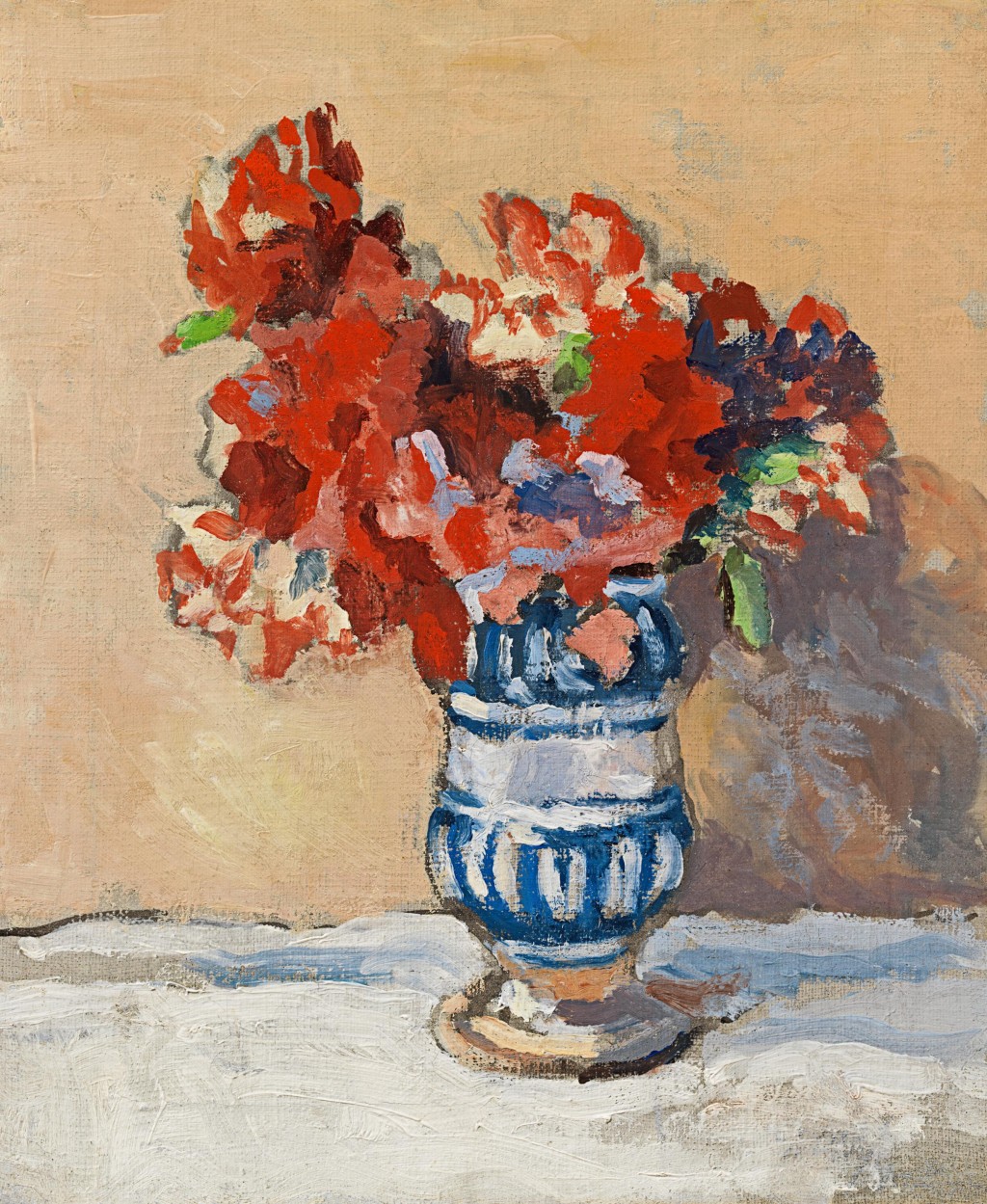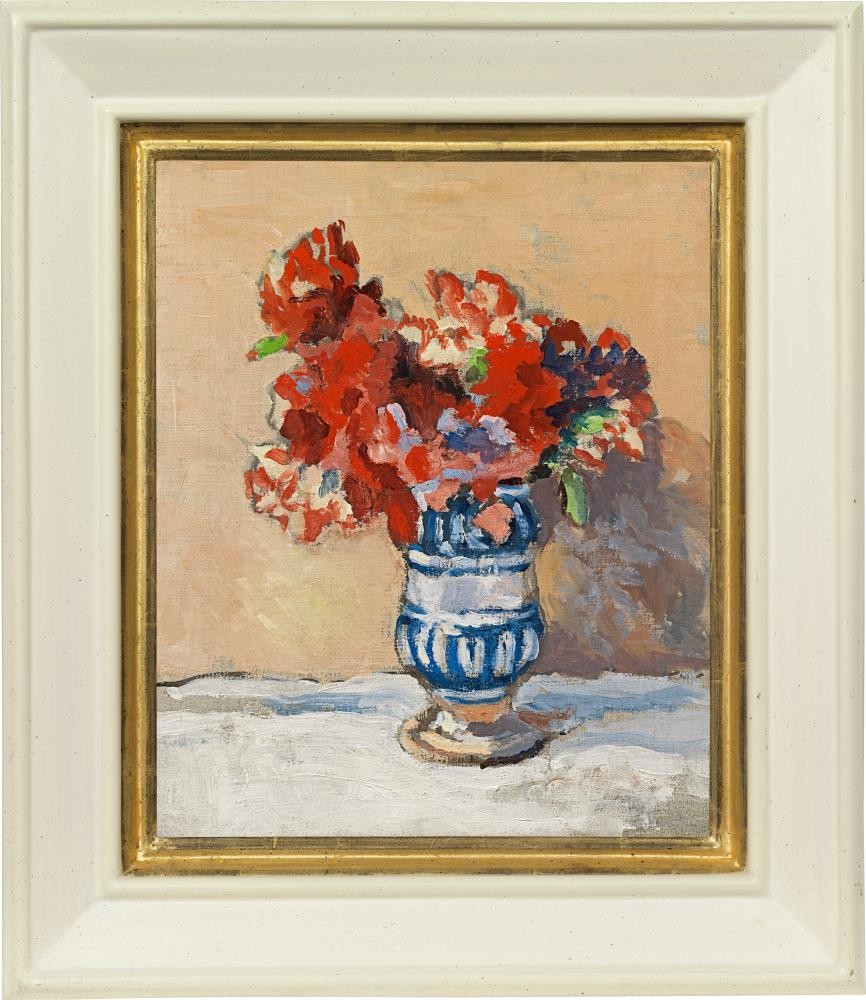CHRISTOPHER WOOD
Knowsley 1901 - 1930 Salisbury
Ref: CA 243
Flowers in a blue vase
Oil on canvas: 14 ¼ x 11 ¾ in / 36.2 x 29.8 cm
Frame size: 19 ½ x 17 ¼ in / 49.5 x 43.8 cm
Painted circa 1922
Provenance:
Jack Beddington CBE (1893-1959)
Hans Juda CBE (1904-1975) & Elsbeth Juda (née Goldstein 1911-2014);
Sotheby & Co., London, 26th April 1972, lot 132;
private collection, UK, acquired from the above and then by descent
Exhibited:
Sheffield, Graves Art Gallery, In Our View: Some paintings and sculpture bought by Hans & Elsbeth Juda between 1931-1967, May-June 1967, cat.no.160, illus. (labels attached to the reverse)
Literature:
Eric Newton, Christopher Wood 1901-1930, William Heinemann for the Redfern Gallery, London, 1938, p,65, cat. no.9
Christopher Wood’s early still lifes, such as Flowers in a blue vase and Lemons in a blue basket at Pallant House Gallery, Chichester, have an irresistible charm, full of warmth, feeling and freshness of vision. Wood was influenced in these crucial early works by Cézanne and Van Gogh, whose letters he discovered in 1922. Katy Norris writes, ‘Wood observed a perfect synergy between the simplicity of Van Gogh’s paintings and his modest rural existence that was to have a determining impact on the young artist’s own approach to art and life.’[1] Many parallels can be drawn between the two artists’ lives, beyond the expressive nature of their work. Both painters were essentially self-taught, terrific correspondents – Wood to his mother, Van Gogh to his brother - both produced their life’s work in less than a decade and died tragically young at the height of their ability.
Wood is known to have painted flower-pieces in watercolour from 1921 and in oil from 1922, his early works usually restricted to one variety of cut flower per painting, including Poppies, Mimosa, Dahlias, Tulips, Anemones, Lilies, Chrysanthemums, Carnations and Irises held in jugs and jars. He later began to represent potted plants such as Cyclamen, Hyacinth, Crocuses and Daffodils, combining flowers and genres including still life and nudes. Following his meeting and blossoming friendship with Ben and Winifred Nicholson in 1926, his floral arrangements were sometimes placed before a window looking out onto the landscape of Cornwall or Cumberland. Flower pieces by Christopher Wood are in the public collections of Leicestershire County Council Artworks Collection; Kettle’s Yard, University of Cambridge; Newport Museum and Art Gallery; Leeds Museums and Galleries; and Manchester Art Gallery.
This delightful work was previously part of two important collections. Jack Beddington is celebrated for posters and press campaigns created under his aegis as publicity manager for Shell-Mex and BP Ltd from 1932, for which he commissioned contemporary artists including Graham Sutherland, Paul Nash, Ben Nicholson and Edward Bawden. He was also responsible for publishing the Shell County Guides from 1934, suggested to him by John Betjeman. During the Second World War he became Director of Films for the Ministry of Information, producing documentaries such as Desert Victory and The True Glory. He was an honorary fellow of the Society of Industrial Artists as well as the Royal Society of Arts; a governor of the Foundation for Visual Education and a member of the National Advisory Council on Art Education and the council of the Royal College of Art.
The painting was later part of the collection of Hans Juda, founder of The Ambassador, an international export journal for textiles, and his wife Elsbeth, a pioneering fashion and art photographer, whose subjects included Henry Moore, John Piper, Peter Blake and Graham Sutherland. In his foreword to the exhibition of their collection held at Graves Art Gallery, Sheffield in 1967, Robert Melville writes, ‘It was in the thirties that Hans Juda founded the magazine The Ambassador to promote higher design standards and efficient export marketing techniques in British industry, perhaps with a special emphasis on dress and furnishing textiles. It is probably the most daring and enterprising trade journal that has ever been conceived: certainly I know of no other magazine which has so consistently and brilliantly demonstrated the relevance of works of art to the problems of industrial design.’[2]
Hans was Editor and Publisher of The Ambassador for nearly thirty years, and when it became part of the Thomson empire in 1964 he joined the Board of Thomson Publications and later became Chairman of the journal. After initially translating for Hans, Elsbeth took up photography soon after they arrived from Berlin, and later became chief photographer and Associate Editor of The Ambassador. Elsbeth accompanied Graham Sutherland on his last visit to Chartwell in 1954 in preparation for his notorious portrait of Sir Winston Churchill, producing photographic studies of Churchill’s face and hands for the artist.
Like Beddington, Hans and Elsbeth frequently commissioned and associated with modern artists including Edward Wadsworth, Louis Le Brocquy, Jo Tilson, Graham Sutherland, Henry Moore and John Piper, and went on to add works by them to their collection. Hans and Elsbeth later sold their art collection to create a fund for British artists.
[1] Katy Norris, Christopher Wood, exh. cat., Lund Humphries in association with Pallant House Gallery, London, 2016, p.46.
[2] Robert Melville, ‘Foreword’, In Our View: Some paintings and sculpture bought be Hans & Elsbeth Juda between 1931-1967, op.cit.

























